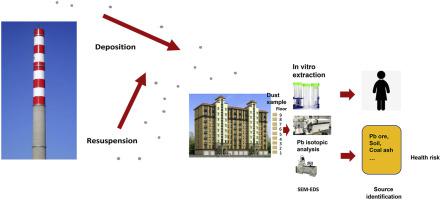Environmental Pollution ( IF 8.9 ) Pub Date : 2020-06-29 , DOI: 10.1016/j.envpol.2020.115110 Weiqin Xing 1 , Hao Yang 1 , James A Ippolito 2 , Yuqing Zhang 1 , Kirk G Scheckel 3 , Liping Li 1

|
Windowsill, heavy metal-containing dust samples, collected at different building heights, may provide some insight into both source and human health risk. Windowsill dust samples were collected from the 1st to 9th floor (1.4–23.2 m above ground) near a lead smelter (1 km to the smelter) and in urban areas (4.2–7.3 km to the smelter) and separated into <10, 10–45 and 45–125 μm size fractions. Samples were extracted with artificial lysosomal fluid (ALF) and the physiologically based extraction test (PBET) (<10 μm fractions only), subjected to scanning electron microscopy-energy dispersive x-ray spectroscopy (SEM-EDS) and Pb isotopic analysis. Greater Pb concentrations were found in 10–45 μm fraction than the other size fractions; at the PX site, dust Pb concentrations increased with windowsill height, while an opposite trend was found at other sites. Isotopic analysis and SEM-EDS results supported this contention. Higher floor samples collected near the smelter were more affected by lead smelting than lower floor samples; lower floor samples collected at urban sites were more affected by resuspended Pb-laden particles from the ground than higher floors. The Pb bioaccessible fraction (BAF) in the ALF and PBET ranged between 68.9-90.1 and 1.3–17.0%, respectively; urban samples had greater BAF values than samples collected near the smelter. This, first of its kind investigation regarding Pb in dusts at different building heights, provides further insight for reducing human health risks within Pb smelter vicinities.
中文翻译:

铅冶炼影响区窗台粉尘中铅的来源和生物可及性。
在不同建筑物高度收集的窗台上含重金属的灰尘样本可以提供一些关于来源和人类健康风险的见解。从铅冶炼厂附近(距冶炼厂 1 公里)和市区(距冶炼厂 4.2-7.3 公里)的 1 楼至 9 楼(距地面 1.4-23.2 m)收集窗台灰尘样品,并将其分为 <10、10 –45 和 45–125 μm 尺寸级分。用人工溶酶体液 (ALF) 和基于生理的提取试验 (PBET)(仅<10 μm 级分)提取样品,进行扫描电子显微镜-能量色散 X 射线光谱 (SEM-EDS) 和 Pb 同位素分析。在 10-45 μm 的部分中发现的 Pb 浓度高于其他尺寸部分;在 PX 现场,灰尘 Pb 浓度随着窗台高度的增加而增加,而在其他站点发现了相反的趋势。同位素分析和 SEM-EDS 结果支持了这一论点。在冶炼厂附近采集的高层样品比低层样品受铅冶炼的影响更大;在城市站点采集的低层样品比高层层更容易受到来自地面的重新悬浮的含铅颗粒的影响。ALF 和 PBET 中的铅生物可及分数 (BAF) 分别在 68.9-90.1 和 1.3-17.0% 之间;城市样本的 BAF 值高于在冶炼厂附近采集的样本。这是对不同建筑高度粉尘中铅的首次调查,为降低铅冶炼厂附近的人类健康风险提供了进一步的见解。在冶炼厂附近采集的高层样品比低层样品受铅冶炼的影响更大;在城市站点采集的低层样品比高层层更容易受到来自地面的重新悬浮的含铅颗粒的影响。ALF 和 PBET 中的铅生物可及分数 (BAF) 分别在 68.9-90.1 和 1.3-17.0% 之间;城市样本的 BAF 值高于在冶炼厂附近采集的样本。这是对不同建筑高度粉尘中铅的首次调查,为降低铅冶炼厂附近的人类健康风险提供了进一步的见解。在冶炼厂附近采集的高层样品比低层样品受铅冶炼的影响更大;在城市站点采集的低层样品比高层层更容易受到来自地面的重新悬浮的含铅颗粒的影响。ALF 和 PBET 中的铅生物可及分数 (BAF) 分别在 68.9-90.1 和 1.3-17.0% 之间;城市样本的 BAF 值高于在冶炼厂附近采集的样本。这是对不同建筑高度粉尘中铅的首次调查,为降低铅冶炼厂附近的人类健康风险提供了进一步的见解。ALF 和 PBET 中的铅生物可及分数 (BAF) 分别在 68.9-90.1 和 1.3-17.0% 之间;城市样本的 BAF 值高于在冶炼厂附近采集的样本。这是对不同建筑高度粉尘中铅的首次调查,为降低铅冶炼厂附近的人类健康风险提供了进一步的见解。ALF 和 PBET 中的铅生物可及分数 (BAF) 分别在 68.9-90.1 和 1.3-17.0% 之间;城市样本的 BAF 值高于在冶炼厂附近采集的样本。这是对不同建筑高度粉尘中铅的首次调查,为降低铅冶炼厂附近的人类健康风险提供了进一步的见解。



























 京公网安备 11010802027423号
京公网安备 11010802027423号